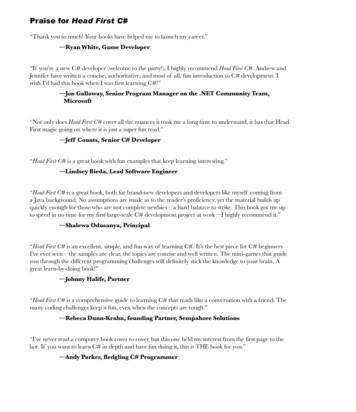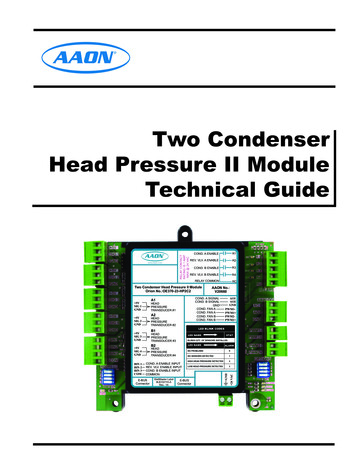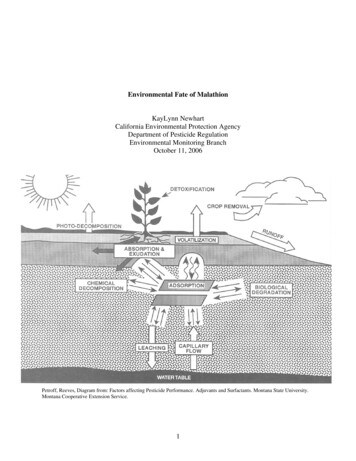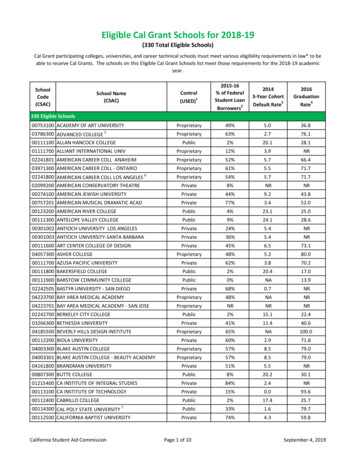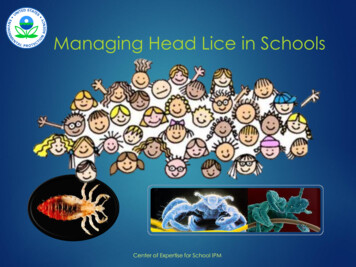
Transcription
Managing Head Lice in SchoolsCenter of Expertise for School IPM
School IPMRefresher Integrated Pest Management (IPM) is a smarter, usuallyless costly option for effective pest control in the schoolcommunity. An IPM program employs common sense strategies toreduce sources of food, water and shelter for pests in yourschool buildings and grounds. IPM programs take advantage of all pest managementstrategies, including the judicious use of pesticides.Center of Expertise for School IPM
IPM BasicsPesticidesPhysical & MechanicalControlsCultural & SanitationPracticesEducation &CommunicationCenter of Expertise for School IPM
Key Concepts Inspect and monitor for pests andpest conducive conditions Prevent and avoid pests throughexclusion and sanitation Use treatments that minimizeimpacts on health and theenvironment Everyone has a role - custodians,teachers, students, principals, andpest management professionalsCenter of Expertise for School IPM
Benefits of School IPM Smart: addresses the root cause of pest problems Sensible: provides a healthier learning environment Sustainable: better long-term control of pestsCenter of Expertise for School IPM
PresentersRichard Pollack, Ph.D. Senior Environmental Public Health Officer, Harvard UniversityPublic Health Entomologist, Harvard School of Public HealthChief Scientific Officer, IdentifyUSInternational expert, presenter and author on medicallyrelevant pestsNichole Bobo, MSN, RN Nursing Education Director, National Assoc. of School NursesOversight of NASN head lice programmingFormerly on faculty of Univ. of Louisville (KY) andRegis Univ. (CO)25 years of clinical nursing experience and adult nursepractitionerDeborah Pontius, MSN, RN, NCSN Health Services Coordinator/Chief School Nurse,Pershing Co. (NV) School DistrictClinician with daily care for students, and health servicesadministrator developing policy and proceduresMember, National Board of Certification for School NursesAuthor of numerous Pediculosis articlesCenter of Expertise for School IPM
Managing Head Lice in SchoolsRichard J. Pollack, PhDIdentifyUS LLC Harvard University & Harvard T.H. Chan Schoolof Public Health Mention of any product name or image is for illustrative purposes only and doesnot indicate endorsement of any product or service. Opinions are those of thepresenter and do not necessarily reflect those of his employers.The presenter declares that he has no conflict of interest.Some images are copyright protected.
Managing Head Lice in Schools BiologyEpidemiologyDispel mythsMedical & public health significanceManagementAudience: School administrators, medicalpersonnel, teachers, parents
Fear trumpsrealityHead liceconcernSpidersBedbugsScabiesLyme diseaseWNvmorbidityInfluenza
Infested scalp hair
Infested scalp hairMisinformedand angryparentsMisinformedand angrypersonnel
Distressedschoolofficials !
It is a myth that head lice: are a sign that a person or home is unclean can jump, fly & survive long off a host infest buildings are readily shared on combs, brushes and hats burrow into skin or transmit infections are resistant to all treatments should prevent a child from attending school
Head lice are insects infest only people (usuallychildren), not pets occur solely on the scalp hair feed only on blood do not burrow into skinEGG1st nymph2nd nymph3rd nymphADULTS
Head louse eggs (‘nits’) and imposters
Not all bugs on the scalp are head liceSpringtailnon-biting, noninfesting M. Plonsky. All rights reservedShared with permission of M. PlonskyHead louseadult femaleBooklousenon-biting, noninfesting Texas A&M University Department ofEntomologyPhoto by M.E. Merchant
Overdiagnosis is the rule,not the exception.Pediatr Infect Dis J. 2000; 19:689-93
A nonsensical claim:“6 - 12 million cases [of head lice] peryear in the U.S.”Enrolled(2009 US Census Bureau)Nursery / KindergartenGrades 1-4TotalNo.(millions)8.815.324.1A misguided extrapolation of marketing statistics
Prevalence Average amongst 5-10yo kids 1% much lower in other age groups‘Outbreaks’ are imagined invariably result from misidentification!
Diagnostic Acumen?DiagnosticianNurse / school nurseCorrect assessment ofinfestation status (%)Extinct&Activeactive7032Teacher / daycareRelativeBarber / beautician636136343618MDSelf211598Pollack et al. Overdiagnosis and Consequent Mismanagment of HeadLouse Infestations in North America. Pediatr Infect Dis J. 2000; 19:68993
How does a person acquire head lice?Probably not from these or other fomites(inanimate objects)
The overly-maligned combHow could a louse– even if alive –grasp this situation?
cussion infographic kids tbi er bus.jpgThe lousiest helmet is one that is not used.Do batting and bike helmets spread head lice?If they do, it would be incredibly rare. Certainlynot a reason not to use them.
Most likely by direct headto-head contact aschildren engage inotherwise wholesomeactivities.
Burden of head louse infestations Parasite load Lice: generally 10 Eggs: few to hundreds (most hatchedor dead)Most cases without symptoms itching transient and usually mild secondary infection (scratching) systemic manifestations uncommon
Financial costs 10 to 1,000 (with lice) often 1,000 when lice onlyimaginedLoss of school time 1 day to 1 year
Managing presumed head louseinfestations‘Nits’discoveredon hair?No Relax. Do NOT treatfor lice.Yes Inspect hair for live (crawling) lice. Compare samples to images atidentify.us.com or submit a sampleor images for evaluation.
Live(crawling)lice onhair?No Periodicallyreinspect hairfor live lice. Do not treat.
How can you get rid of head lice?Anti-lousetreatmentsOTC & RxMechanicalremovalHabitat modification
Is the hairreadily combedwith a lousecomb?NoYes Comb thoroughly.Use conditioner.Repeat as needed.Considertreatment. Treat as per productinstructions). Retreat asappropriate. Consider uments/lice-mgmntchart-school.pdf
Mechanical removal
Over-the-counter (OTC) pediculicidesFDA-registeredPyrethrinsNatural extracts, chrysanthemumsPyrethroidsSynthetic analogues of pyrethrinsDimethicone Lubricant / conditioning agentInexpensive, easy to use, low risk, sometimes effective
“New 'Super Lice' Are ResistantTo Traditional -Kids-and-Parents/17596851Reality or over-interpreted researchfindings and marketing excesses?
Differential Permethrin Susceptibility of Head LiceSampled in the United States and BorneoCorrected Mortality (%)Pollack et al. 1999. Arch. Pediatr. Adolesc Med. 153:969-73BorneoUnited States(corrected by Abbott’sConcentrationofformula)Permethrin (%)
Rx Pediculicides (FDA lice”
Rx Pediculicides (FDA �Ivermectin“Ulesfia”Spinosad“Natroba”May potentially pose unacceptablerisks, particularly if misused.“Sklice”
Recovery looking up for burn victimBy Gavin LesnickThursday, March 26, 2009An 18-year old Evansville woman whosustained serious burns to more thanhalf her body last month is showingmarked improvement at the Universityof Louisville Hospital, her mother saidthis week.Jessica Brooks was burned Feb. 22 after dousing her hairwith gasoline in an attempt to get rid of lice. The pilot ofa nearby water heater ignited the fumes, engulfing herin 6/recoverylooking-upfor-burnvictim/Adding insult to injury: Did she have lice in the first place?
Louse / nit removal servicesAn unregulated industryDiagnoseRarely hold medical credentials.Comb & snip hairRarely licensed as barbers / beauticians.Formulate, sell and apply anti-louse productsRarely approved by FDA or EPA, nor arethe salons licensed as pest controlprofessionals.
Recommended responses Confirm specimen ID Notify parent / guardian at the end ofthe day Provide educational information on thebiology & management of head lice
Unjustified responses Excluding / quarantining student & possessions Violating confidentiality or notifying otherstudents / parents Mass screening Applying pesticides to classrooms & buses Reporting cases to youth / social services Bagging clothing Restricting use of headphones / helmets
LousypolicyNo-nit policies to reduceincidence and/orprevalenceWhat’s wrong with them? No objective basis for no-nit or no-louse policy No medical or public health justification Training, equipment, regulation issues Mistakenly assume transmission within school Wrongly assume ‘nits’ are viable and/ortransmissible Burdensome to children, school personnel,parents
Why many school systems havechanged their policies Lack of medical / public health justification Inappropriate use of school nurse time Child, parental & staff distress Unnecessary absences from school Goals: Evidence-Based Practice
l Students diagnosed with live head lice do not need tobe sent home early from school; they can go home atthe end of the day, be treated, and return to classafter appropriate treatment has begun Personal hygiene or cleanliness in the home or schoolhas nothing to do with getting head lice The burden of unnecessary absenteeism to thestudents, families and communities far outweighs therisks associated with head lice
CD Devore, GE. Schutz. Head lice.PEDIATRICS Volume 135 (5), May 135/5/e1355.full.pdf “No healthy child should be excluded from or allowedto miss school time because of head lice or nits.” “School personnel involved in detection of head liceinfestation should be appropriately trained. Theimportance and difficulty of correctly diagnosing anactive head lice infestation should be emphasized.” “Head lice screening programs have not been provento have a significant effect over time on the incidenceof head lice in the school setting and are not costeffective.”
Pediculosis Management in theSchool SettingIt is the position of the National Association of SchoolNurses that the management of pediculosis (infestationby head lice) should not disrupt the educationalprocess. No disease is associated with head lice, andin-school transmission is considered to be rare.Children found with live head lice should remain eSchool-Setting-Revised-2011
IPM for Head LiceHead lice are obligate parasites & arenot free living. Hence, head lice are a medicalissue, not a pest control problem. School & pest managementpersonnel can do nothing toprevent or eliminate head lice.
IPM efforts directed against head liceshould be highly focused . on thehead. Schools can provide educationalresources and rely on medicalexperts. No basis to treat environment or foranyone other than the child’s caregiver and medically trained personnelto examine a child.
Perspective Head lice: an occasional malady ofchildhood The most trivial of the social ‘diseases’ achild may acquire. Compare to: Viruses:Cold & influenza Parasites: Pinworms Fungal:Athlete’s foot, ringwormHead lice indicate that the child hasfriends.
Rapid, Independent, Confidential & Expertevaluations of pests and digital images.https://identify.us.com Offer independent assurance Insulate school nurse from controversy Reduce unnecessary absentee rates & treatments
American Academy of ontent/135/5/e1355.full.pdfNational Association of School e-School-SettingRevised-2011US Centers for Disease Control and g/head-lice/index.html
Managing Head Lice inSchools – NASN PerspectiveCENTER OF EXPERTISE FOR SCHOOLINTEGRATED PEST MANAGEMENTU.S. ENVIRONMENTAL PROTECTION AGENCYOCTOBER 20, 2015Nichole Bobo, MSN, RNDirector of Nursing Educationnbobo@nasn.orgCenter of Expertise for School IPM
Objectives Identify the key components of NASN’sposition on the management of headlice in schools Describe the NASN tools and resources tosupport school nursing practice related tothe management of head lice in schoolsCenter of Expertise for School IPM
NASN’s Position(2011) Remain in classDiscourage head-to-head contactNotify parent/caregivers at end of school dayScreen known contactsAbandon “no-nit” school policiesEliminate classroom wide screeningLetters home to provide 011pspediculosis.pdfCenter of Expertise for School IPM
Framework for 21st CenturySchool Nursing Practice(NASN, 2015)Center of Expertise for School IPM
Center of Expertise for School IPM
Managing Head LiceRole of the School NurseCare dershipAdvocacyPolicy Development& ImplementationQualityImprovementEvaluationPublic HealthMeaningful Health &Academic Outcomes(NASN, 2015; NASN, 2010;ANA & NASN, 2011)EnvironmentalHealthHealth EducationStandards of PracticeEvidence-basedPracticeNASN PositionStatementsCenter of Expertisefor School IPM
NASN Webpage:Head Lice – Pediculosis capitis Resource Publications National Resources In the LicePediculosisCapitisCenter of Expertise for School IPM
Education Campaign:Headfirst Lice ePediculosisCapitis/HeadfirstLiceLessonsCenter of Expertise for School IPM
http://headfirstlicelessons.org/Center of Expertise for School IPM
Other NASN Resources Back to school toolkit NASN RadioCenter of Expertise for School IPM
BETTER HEALTH. BETTERLEARNING.TMCenter of Expertise for School IPM
ReferencesAmerican Nurses Association & National Association of SchoolNurses. (2011). School nursing: Scope and standards ofpractice (2nd ed.). Silver Spring, MD: Nursebooks.org.National Association of School Nurses. (2015). Framework for 21stcentury school nursing practice. NASN School Nurse, 20(4),218-231.National Association of School Nurses. (2011). Pediculosismanagement in the school setting (Position Statement). SilverSpring, MD: Author.Center of Expertise for School IPM
Head Lice inSchoolsSCHOOL NURSES LICE QUEENS!Deborah Pontius, MSN, RN, NCSNHealth Services Coordinator/Chief SchoolNursePershing CenterCountySchool Districtof Expertise for School IPMLovelock, NV
Goals of LiceManagement in School Treat and eliminate lice as quickly and safelyas possible Avoid interfering with education; minimizeschool absences Do not stigmatize or embarrass child or family Minimize recurrence by educating parents andthe communityCenter of Expertise for School IPM
Challenges of Lice in School Myths Lack of understanding of transmissionand life cycle Stigma and embarrassment Privacy and confidentiality Parental resistance to no exclusion/notification Exclusions interfere with educationCenter of Expertise for School IPM
Role of the School 1NurseLice expert: Key health professional Identify, confirm, and contain infestation Provide information to parents,school, and community on treatment Prevent overexposure to chemicals Minimize school absence Educate and advocate to— Eliminate exclusionary policies Implement evidence-based policiesReference: 1. Pontius, DJ, Teskey C. Pediculosis Management in the School Setting. NationalAssociation of School Nurses (NASN), 2011 Position Statement. http://www.nasn.org.Accessed August 16, 2012.Center of Expertise for School IPM
Advocating for EvidenceBased Lice Policies If you have no policy, do not create policy Gather your own statistics Research evidence NASN Position Statement AAP Position Statement CDC Pollack et alPrepare action planCenter of Expertise for School IPM
What is Wrong WithNo-Nit Polices? Assume nits are viable and easily transmissible Assume transmission likely within school Not based on mythsReferences: Pontius DJ. NASN School Nurse. 2011;26(6):356-362. Pontius DJ. PediatricNursing. 2014:40(5):226-235Center of Expertise for School IPM
Goals of New Lice Policy1 Move to evidence-based practice Effectively, quickly, and safely eliminate student infestations Community education Changed perceptionImproved attendance NO exclusions Nurse-parent partnership Confident self-careIncreased academic excellence No lags in education Good psychosocial development of studentsReference: 1. Weisberg L. NASN School Nurse. 2009;24(4):165-166.Center of Expertise for School IPM
Parental and TeacherResistance Aggressive demands for no-nit policies,immediate exclusion, notification, andclassroom screenings : Unfamiliar with evidence and new guidelines Fearful of infestation/adhere to old commonpractices Quarantine seems logical in the abstractReferences: Pontius DJ. NASN School Nurse. 2011;26(6):356-362. Pontius DJ. PediatricNursing. 2014:40(5):226-235Center of Expertise for School IPM
School Lice Policies1,2ConventionalWisdom-BasedEvidence-Based Classroom screenings ofinfested student Screening family membersand close contacts Scheduled school-widescreening No regular screenings Notes home to parentsof classmatesNo notification ofclassmate parents Immediate exclusionwhen lices/nits foundNotify parents at the end ofthe school day Only nits closer than ½”from scalp treat orremove No-nit or nit-freeReferences: 1. Weisberg L. NASN School Nurse. 2009;24(4):165-166. 2. Pontius DJ. NASNSchool Nurse. 2011;26(6):356-362.
Components of Model LicePolicy When lice is suspected: Check suspected studentusing privacy measures Check family membersand close contacts Recent overnights Play together oftenoutside of school Shared hair care items Shared bedCenter of Expertise for School IPMImage: CDCPHIL
Components of a Model LicePolicy When live lice or nitsclose to scalp are found Return student to class Notify teacher inconfidential mannerImage: CDCPHILCenter of Expertise for School IPM
Confidentiality & Privacy Do infested students have right to privacy? Do parents of classmates have right to know? Is it possible to keep knowledge of whichstudent confidential? Which is the greater risk? Which right outweighs the other?Center of Expertise for School IPM
Components of Model LicePolicy Notify parents at theend of the school day Focus on educationof parents Treatment regimens What to look for Myths and realitiesImage: CDCPHILCenter of Expertise for School IPM
Components of Model LicePolicy Eliminate no-nit policy Nits farther than ¼”from scalp ignoredImage: CDCPHILCenter of Expertise for School IPM
Components of a ModelLice Policy After treatment-consider Check upon return to school Check 1 week laterNurse has authority to exclude or doclassroom screenings at her discretion Very small children, close contacts Lack of parental follow-throughCenter of Expertise for School IPM
Challenges to Policy Change Myths and fear Personal experience Industry and Organizations Product manufacturers Louse & nitpicking services OrganizationsCenter of Expertise for School IPM
Successful ChangeImplementation1 Ducks in a row Educate board Educate community Educate parents Re-educate as necessary Be prepared for panicReference: 1. PontiusCenterDJ. NASNSchoolNurse.2011;26(6):356-362.of Expertisefor SchoolIPM
Summary: Goals of PediculosisManagement in Schools Educate parents and community Identify, confirm, and contain infestation Prevent overexposure of chemicals Maintain confidentiality and privacy Reduce stigma Minimize school absence Advocate for: Elimination of exclusionary policies Implementation of evidence-based policiesCenter of Expertise for School IPM
Upcoming School IPM WebinarsNov. 10 Writing an IPM Policy for Your School DistrictDec. 15 Bed Bugs in SchoolsJan. 26Stop School Pests and iPestManager – schoolIPM educational programsFeb. 23Procuring IPM-Based Pest Mgmt. ServicesMar. 15 IPM for Turf on School GroundsApr.19Vertebrate Turf PestsMay 17 Ants, The #1 Pest in SchoolsJun. 7Termite Mitigation in SchoolsCenter of Expertise for School IPM
Certificates of AttendanceCenter of Expertise for School IPM
Subscribe NowEPA’s School IPM ListservSubscribers will Receive Webinar Invitations IPM related highlights and articles Updates on EPA school IPM activitiesHow to Subscribe Visit www2.epa.gov/managing-pests-schoolsCenter of Expertise for School IPM
Questions?Center of Expertise for School ging-pests-schools
Clinician with daily care for students, and health services administrator developing policy and procedures Member, National Board of Certification fo

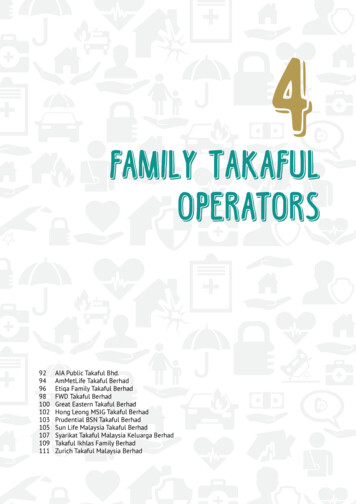
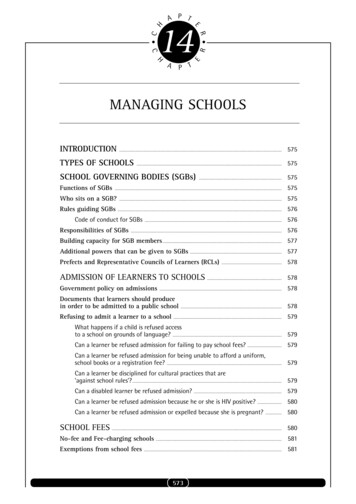

![Drawing the Human Head Burne Hogarth[English] - Internet Archive](/img/29/drawing-the-human-head-burne-hogarth-english.jpg)
